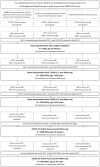Cohort Profile Update: The Neuroscience in Psychiatry Network (NSPN) 2400 cohort during the COVID-19 pandemic
- PMID: 37418602
- PMCID: PMC10749753
- DOI: 10.1093/ije/dyad095
Cohort Profile Update: The Neuroscience in Psychiatry Network (NSPN) 2400 cohort during the COVID-19 pandemic
Erratum in
-
Correction to: Cohort Profile Update: The Neuroscience in Psychiatry Network (NSPN) 2400 cohort during the COVID-19 pandemic.Int J Epidemiol. 2024 Oct 13;53(6):dyae157. doi: 10.1093/ije/dyae157. Int J Epidemiol. 2024. PMID: 39533965 Free PMC article. No abstract available.
Conflict of interest statement
S.R.C. receives honoraria from Elsevier for editorial work outside of the submitted work. Previously, he also consulted for Promentis on topics unrelated to the here submitted article. All other authors declare no competing interests.
Figures



References
-
- Dion J, Matte-Gagné C, Daigneault I et al. A prospective study of the impact of child maltreatment and friend support on psychological distress trajectory: from adolescence to emerging adulthood. J Affect Disord 2016;189:336–43. - PubMed
Publication types
MeSH terms
Grants and funding
LinkOut - more resources
Full Text Sources
Medical

